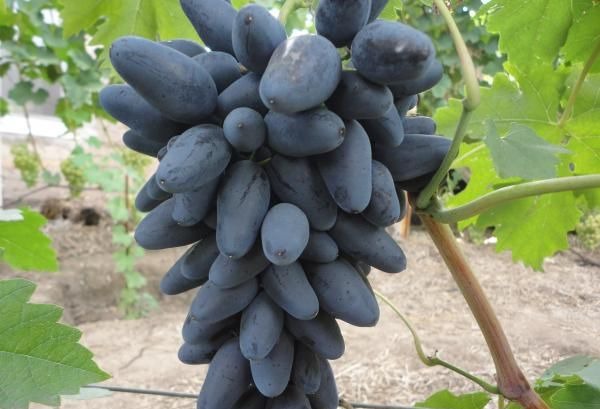
The author of the variety V.V. Zagorulko is a breeder from Ukraine. Two varieties participated in hybridization: Codryanka, AIA. You can meet Viking not only in the southern regions, it is in demand among winegrowers near Moscow. The hybrid form has a catchy berry aroma.
Content
Description and characteristic
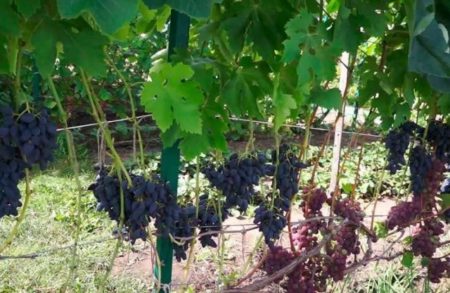
Early ripening form. Mass harvesting begins in the first half of August. The first clusters ripen 100 days after the start of the growing season. There are no problems with breeding, seedlings perfectly take root.
After a period of adaptation, the vine grows rapidly. There are no problems with pollination; Viking's flowers are bisexual. In the temperate climate of the Moscow Region, bushes shelter in winter, they have average frost resistance, and a threshold temperature of 21 ° C.
In the south, the vine and fruit buds do not freeze without shelter. Yield is affected by the weather. Its quality suffers from sharp fluctuations in summer temperatures. The intense heat affects the quality of the bunch and the berries are smaller.
The shape of the cluster is conical, the structure is dense, weight is from 600 to 1000 g. The berries are marketable, elongated-oval, dark blue with a purple tint. Average sizes: length 34 mm, width 22 mm, weight 13 g., Few bones, the skin is edible.
The pulp has a pleasant taste with a slight aftertaste of prunes and subtle notes of muscat. The structure of the pulp is dense. The percentage of sugars is about 16%. The yield of bushes is average. The number of fruiting shoots per bush is about 24 pieces.
Bushes are vigorous, covered with five-lobed leaves, shoots ripen early, the percentage of maturation is high. Grape growers use different types of forming crop:
- cordon;
- fan;
- gazebo.
Grapes have a table setting. Taste and useful composition of the pulp involves the use of fresh berries. Viking is in demand among retail buyers. Farmers grow a hybrid for sale.
Clusters can hang on bushes all September. It is convenient for trading. The appearance and taste of the berries lasts a long time, they tolerate long transportation well. Viking berries can be used as raw materials in home winemaking.
Growing regions
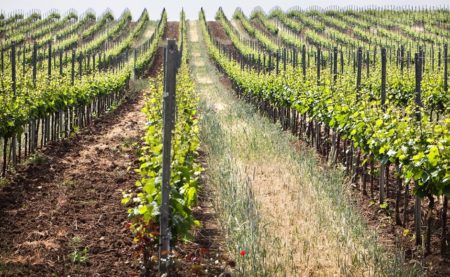
A suitable climate for growing Viking in the southern regions, but winegrowers in the Moscow region, Primorsky Territory and the Urals breed this hybrid in their dachas. Amateurs from the central Russian regions are not far behind them.
Advantages and disadvantages
Early ripening, original aroma and aftertaste are Viking's undoubted advantages. It is also appreciated that the crop can remain on the bushes for a long time without loss of consumer properties. The advantages include the good transportability of Viking clusters, the good maturation of the shoots.
The minuses include:
- the need for shelter due to the average frost resistance of grapes;
- cracking during prolonged rains;
- low immunity to fungal infection.
Landing
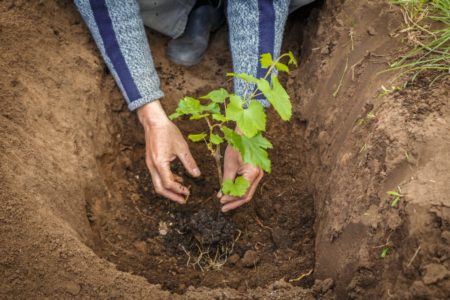
The ground level is raised, forming embankments up to 1.5 meters high, if groundwater is close. They control the pH level of the soil and, if necessary, bring it back to normal. Horse peat is added to alkaline, it increases acidity, and in acidic - slaked lime, dolomite flour, ash.
They dig a pit for planting in the fall, at the same time preparing the soil mixture for backfilling. Seedlings prefer to plant in early spring. A talker is made of clay, water, humus.The roots of grapes are immersed in it before planting. Shoots are cut for 2-3 buds. Poured soil is compacted, watered.
Care Features
In arid regions, which include the Astrakhan and Volgograd regions, much attention is paid to watering. In areas with normal rainfall, fruiting Viking bushes are watered according to the standard scheme:
- in the spring, when the shoots grow 25-30 centimeters;
- before flowering;
- when clusters begin to form;
- after harvesting;
- before the onset of frost.
Additional watering is carried out in cases where it is necessary to fertilize with mineral fertilizers or the berries have lost their elasticity.
Viking for the season enough 3 feeding. Spend them once a month. In the first half of summer, grapes need nitrogen-containing fertilizers, in the second - with phosphorus and potassium. Once every 3 years, soil fertility in the root zone is restored. They dig a shallow trench along the trellis, cover it with humus. It is not worth overdoing with nitrogen fertilizing, the Viking does not particularly like them.
In the first years after planting, average pruning of shoots for 5 buds is used. Subsequently, they switch to a long one, leaving 18 to 20 eyes on the fruiting shoots.
Attitude to disease
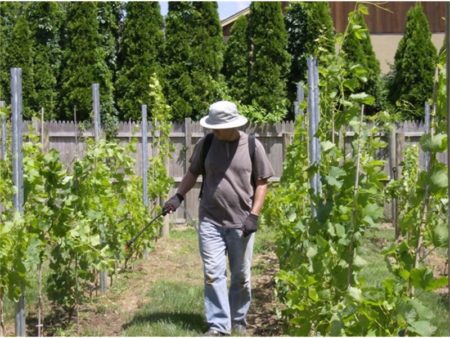
Afraid of Viking rot and other fungal diseases. Need prevention. Events begin in early spring. As soon as the aerial part grows by 20 cm, the first treatment is carried out, the second proceed before flowering, and the last after it.
Popular drugs among winegrowers:
- Bordeaux fluid;
- Gates;
- Anthracol.
Other preventive work: removing stepchildren and extra shoots, weeding row spacing, controlling moisture with mulch.
Pests
You need to be careful of birds and wasps. From their attacks, the crop can be seriously affected. Standard control measures: net from birds, sacs from wasps.
Preparation for winter
They cover the vine before the onset of frost, most often work is carried out in late October - early November. Time depends on the weather and climate zone. Arc and PVC film are the perfect choice.
Arcs are set after the pruned vine is removed from the trellis, and laid on cleared soil from weeds and plant debris. A film is pulled on them, leaving the ends open. They are closed after persistent frost is set at not lower than -8 ° C.
While the weather is relatively warm, air should circulate freely in the tunnel. Shoots should not touch the film. Contact with covering material in frost will cause frostbite of the bush.
Reviews
Matvey, Bryansk region
The berries have an attractive shape, good taste, no cod. Fruits in 2013, does not get sick. Growth power is great. Crops from 2017 are stably high, bushes withstand overload. Viking can be advised to winegrowers from the northern regions.
Maxim, Volgograd region
Due to the large growth force, the trellis bushes need up to 5 meters. My Viking is growing on a single-plane 3-meter trellis, it's not enough. Care and crop quality greatly affect yield. I spend a long pruning (from 15 to 18 eyes). With prolonged rains it bursts. The taste is pleasant, but simple, and in wet weather it noticeably worsens. This grade for damp climate I do not recommend.
Nikolay, Pyatigorsk
The Viking did not go with me, knocked it out. The bushes are gigantic, on my one plane there was not enough space, I was not happy with productivity. He needs an L-shaped trellis. The berry tastes the most common, peeling happens in the rains.

 Non-covering winter-hardy grape varieties for Moscow region
Non-covering winter-hardy grape varieties for Moscow region How to keep the vine in winter
How to keep the vine in winter When can I transfer grapes to another place in the fall
When can I transfer grapes to another place in the fall How to cover and prepare grapes for the winter in the suburbs
How to cover and prepare grapes for the winter in the suburbs